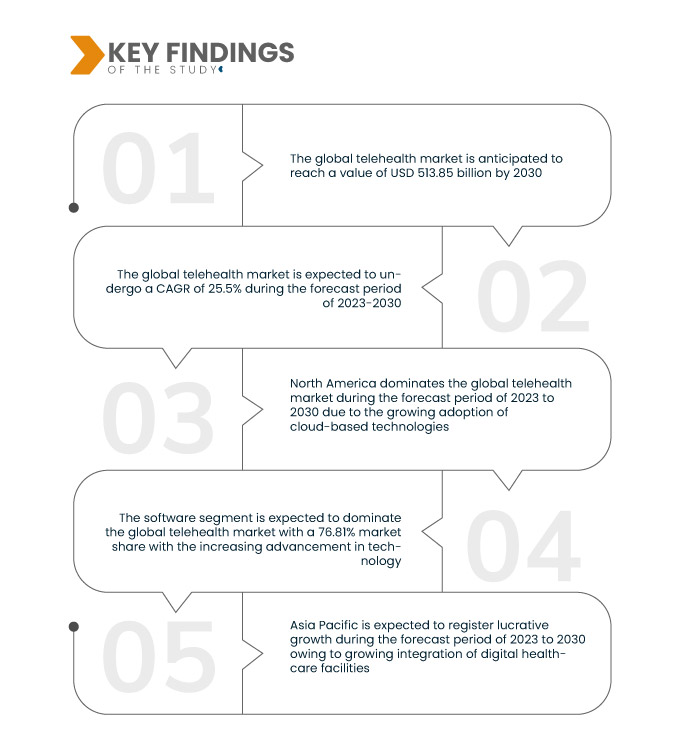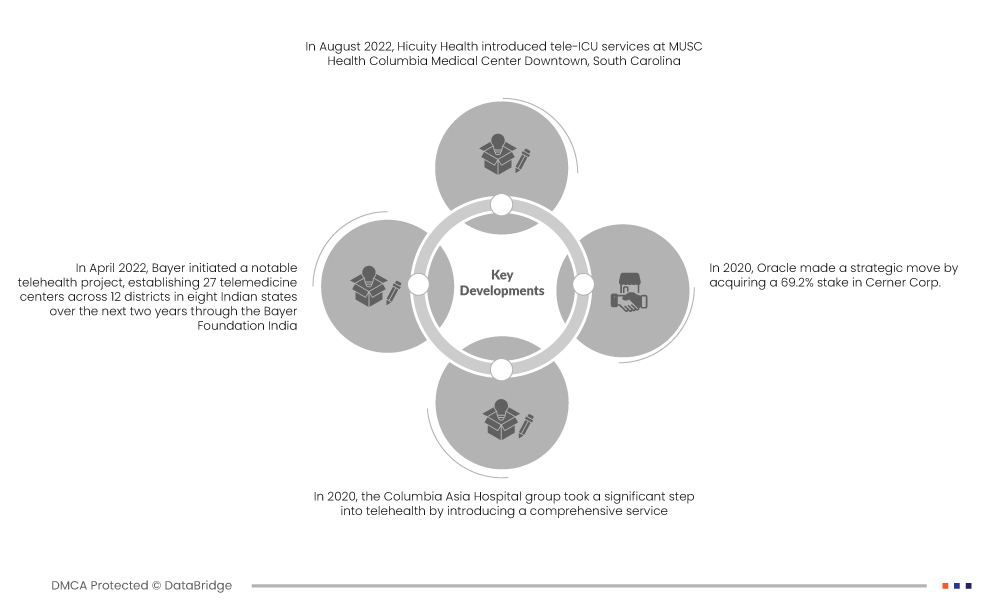Chronic diseases such as cardiovascular diseases, diabetes, and respiratory illnesses require ongoing management and monitoring, often involving frequent visits to healthcare providers. Telehealth offers a suitable and cost-effective way to manage these conditions remotely, allowing patients to receive care without the need for frequent in-person visits.
Telehealth platforms can enable patients to monitor their vital signs, track their symptoms, and communicate with healthcare providers from their homes. This not only improves convenience for patients but also allows healthcare providers to monitor patients more closely and intervene early if any issues arise. Additionally, telehealth can help reduce healthcare costs associated with chronic disease management, as it can reduce the need for hospitalizations and emergency room visits.
Access Full Report @ https://www.databridgemarketresearch.com/reports/global-telehealth-market
Data Bridge Market Research analyzes that the Global Telehealth Market is expected to reach USD 105.02 billion by 2031 from USD 32.58 billion in 2023, growing at a CAGR of 16.2% in the forecast period of 2024 to 2031.
Key Findings of the Study
Accessible and Widely Adopted mHealth Applications
Mobile health applications, often available on smartphones and tablets, allow patients to access healthcare services and information remotely. They can facilitate various telehealth services, such as virtual consultations with healthcare providers, remote monitoring of vital signs, and medication reminders. The widespread adoption of smartphones and tablets worldwide has made it easier for patients to access mHealth applications, regardless of their location. This increased accessibility has expanded the reach of telehealth services, especially in rural or underserved areas where access to traditional healthcare facilities may be limited.
Furthermore, the user-friendly interfaces and functionalities of mHealth applications have contributed to their widespread adoption among patients. These applications are often designed to be intuitive and easy to use, allowing patients to manage their health more effectively and engage with telehealth services more readily.
Report Scope and Market Segmentation
|
Report Metric
|
Details
|
|
Forecast Period
|
2024 to 2031
|
|
Base Year
|
2023
|
|
Historic Years
|
2022 (Customizable to 2016–2021)
|
|
Quantitative Units
|
Revenue in USD Billion
|
|
Segments Covered
|
Component (Hardware, Telecommunication /Services, Software, and Integrated Systems), Delivery Mode (Cloud-Based Delivery Mode, Web-Based Delivery Mode, and On-Premise Delivery Mode), Mode of Purchase (Group Purchase and Individual Purchase), Application (General Consultation, Pathology, Neurology, Cardiology, Dermatology, Surgery, Gynecology, Orthopedics, Ophthalmology, Radiology, and Others), End User (Hospital Telehealth, Physician Telehealth, Home Telehealth, and Others)
|
|
Countries Covered
|
U.S., Canada, Mexico, Germany, U.K., France, Italy, Netherlands, Spain, Russia, Switzerland, Turkey, Belgium, Rest of Europe, China, Japan, India, South Korea, Australia, Singapore, Thailand, Indonesia, Malaysia, Philippines, Rest of Asia-Pacific, Brazil, Argentina, Rest of South America, Saudi Arabia, U.A.E., South Africa, Egypt, and Rest of Middle East and Africa
|
|
Market Players Covered
|
Walmart Health Virtual Care (U.S.), Teladoc Health, Inc. (U.S.), Medtronic (U.S.), Koninklijke Philips N. V. (Netherlands), Honeywell International Inc. (U.S.), LanguageLine Solutions (U.S.), Siemens Healthineers AG (Germany), F. Hoffmann-La Roche Ltd. (Switzerland), AMN Healthcare Services Inc. (U.S.), Included Health Inc. (U.S.), American Well (Amwell) (U.S.), MDLIVE (U.S.), Oracle (U.S.), GCX Corporation (U.S.), Caregility (U.S.), PlushCare (U.S.), Teleray.com (U.S.), Aerotel Medical Systems Ltd. (Israel), GE Healthcare (U.S.), Access TeleCare, LLC (U.S.), Sesame Inc. (U.S.), CyraCom International, Inc. (U.S.), Propio Language Services (U.S.), Interactive Digital Solutions (U.S.), TelMDFirst (U.S.), Artisight (U.S.), and Omron Healthcare Inc. (Japan) among others.
|
|
Data Points Covered in the Report
|
In addition to the insights on market scenarios such as market value, growth rate, segmentation, geographical coverage, and major players, the market reports curated by the Data Bridge Market Research also include depth expert analysis, patient epidemiology, pipeline analysis, pricing analysis, and regulatory framework.
|
Segment Analysis
The global telehealth market is segmented into five notable segments based on component, delivery mode, mode of purchase, application, and end user.
- On the basis of component, the global telehealth market is segmented into hardware, telecommunication/services, software, and integrated systems
In 2024, the hardware segment is expected to dominate the Global Telehealth Market
In 2024, the hardware segment is expected to dominate the market with the market share of 41.89% due to increasing focus on personalized devices for users.
- On the basis of delivery mode, the global telehealth market is segmented into cloud-based delivery mode, web-based delivery mode, and on-premise delivery mode
In 2024, the cloud-based delivery mode segment is expected to dominate the Global Telehealth Market
In 2024, the cloud based delivery mode segment is expected to dominate the market with a market share of 51.32% as cloud-based solutions offer scalability, allowing healthcare providers to easily scale their telehealth services up or down based on demand.
- On the basis of mode of purchase, the global telehealth market is segmented into group purchase and individual purchase. In 2024, the group purchase segment is expected to dominate the market with a market share of 56.46%
- On the basis of application, the global telehealth market is segmented into general consultation, pathology, neurology, cardiology, dermatology, surgery, gynecology, orthopedics, ophthalmology, radiology, and others. In 2024, the general consultation segment is expected to dominate the market with a market share of 20.63%
- On the basis of end user, the global telehealth market is segmented into hospitals telehealth, physician telehealth, home telehealth, others. In 2024, the hospitals telehealth segment is expected to dominate the market with a market share of 42.66%
Major Players
Data Bridge Market Research analyzes Walmart Health Virtual Care (U.S.), Teladoc Health Inc. (U.S.), Medtronic (Ireland), Koninklijke Philips N.V. (Netherlands), Honeywell International Inc. (U.S.) as the major companies operating in the market.
Market Developments
- In February 2022, Teladoc Health Inc. announced the first-of-its-kind experience with Amazon Alexa with the launch of voice-activated general medical virtual care on supported Echo devices, such as an Echo, Echo Dot, and Echo Show. This has increased the company's sales and product portfolio
- In April 2024, Philips Foundation and March of Dimes team up to enhance prenatal care access in underserved areas, tackling US maternal and infant health issues. Philips will supply ultrasound technology for telehealth in three mobile health centers, assist with staffing and operations, and offer allowances for local healthcare partners and community workers. This partnership will help Philips improve its brand image and expand its market reach by addressing critical healthcare needs in underserved communities
- In January 2023, Royal Philips and Masimo are expanding their partnership to enhance patient monitoring in home telehealth with the Masimo W1 health tracking watch. The W1 will integrate with Philips's patient monitoring system, advancing telemonitoring and telehealth. This partnership will allow Philips to offer more comprehensive and advanced telemonitoring solutions, strengthening its position in the telehealth market and potentially increasing its revenue streams
- In October 2021, Honeywell International Inc. unveiled its Real-Time Health Monitoring System (RTHMS), a cutting-edge platform for remote patient monitoring. RTHMS integrates hardware and software, enhancing care delivery and healthcare worker productivity. It slashes hospital administrative tasks by 35%, potentially boosting Honeywell's growth by improving healthcare efficiency and patient outcomes
- In March 2022, American Well announced that they had joined forces with global innovator LG Electronics to expand the boundaries of virtual care. The two companies plan to jointly develop new device-based service solutions designed to make it easier for patients to access care, whether in a hospital or at home, which has increased the company's sales
Geographical Analysis
Geographically, the countries covered in the telehealth market report are the U.S., Canada, Mexico, Germany, U.K., France, Italy, Netherlands, Spain, Russia, Switzerland, Turkey, Belgium, rest of Europe, China, Japan, India, South Korea, Australia, Singapore, Thailand, Indonesia, Malaysia, Philippines, rest of Asia-Pacific, Brazil, Argentina, rest of South America, Saudi Arabia, U.A.E., South Africa, Egypt, and rest of Middle East and Africa.
As per Data Bridge Market Research analysis:
North America is estimated to be the dominant and fastest growing region in the Global Telehealth Market
North America is estimated to be the dominant and fastest growing region in the global telehealth market owing to the rising awareness among people. The strong healthcare system, and supportive government policies are the factors contributing towards growth.
For more detailed information about the global telehealth market report, click here – https://www.databridgemarketresearch.com/reports/global-telehealth-market












